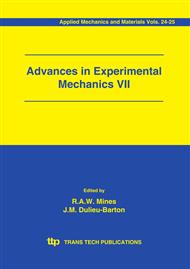p.299
p.305
p.311
p.317
p.325
p.331
p.337
p.343
p.349
Tensile Properties of Die-Cast Magnesium Alloy AZ91D at High Strain Rates in the Range between 300 s-1 and 1500 s-1
Abstract:
Magnesium alloys have been increasingly used in the automobile, aerospace and communication industries due to their low density, high strength to weight ratio, good impact resistance and castability. Magnesium alloys, previously not used in load bearing components and structural parts are strongly being considered for use in such applications. Impact events in vehicles and airplanes as well as developments in weaponry and high speed metal working are all characterized by high rates of loading. Understanding of the dynamic behaviour of materials is critical for proper design and use in different applications. In the current study, a cast magnesium alloy AZ91D has been investigated at quasi-static and higher strain rates in the range between 300 s-1 and 1500 s-1. The INSTRON machine was used to perform the quasi-static tests. High strain rate tests have been performed using the Split Hopkinson Tensile Bar (SHTB), a very useful and widely used tool to study the dynamic behaviour of variety of engineering materials. The results of a tensile testing indicate that the tensile properties including yield strength (YS), ultimate tensile strength (UTS) and the elongation at fracture (Ef) are affected by the strain rate variation. Higher stresses are associated with higher strain rates. The alloy AZ91D displays approximately 45% higher tensile stresses at an average strain rate of approximately 1215/s than at quasi-static strain rate. The dependence of the yield stress and tensile strength on the strain rate in the range of high strain rate above 1000 s-1 is larger than that at lower strain rates. The alloy AZ91D is observed to be more strain rate sensitive for strain rate higher than 1000 s-1. A decrease in the strain rate sensitivity is also observed with the increasing strain in the specimen. It is observed that the hardening behaviour of the alloy is affected with increasing the strain rate. At high strain rates, the fracture of magnesium alloy AZ91D tends to transit from ductile to brittle.
Info:
Periodical:
Pages:
325-330
Citation:
Online since:
June 2010
Authors:
Permissions:
Share:
Citation:


